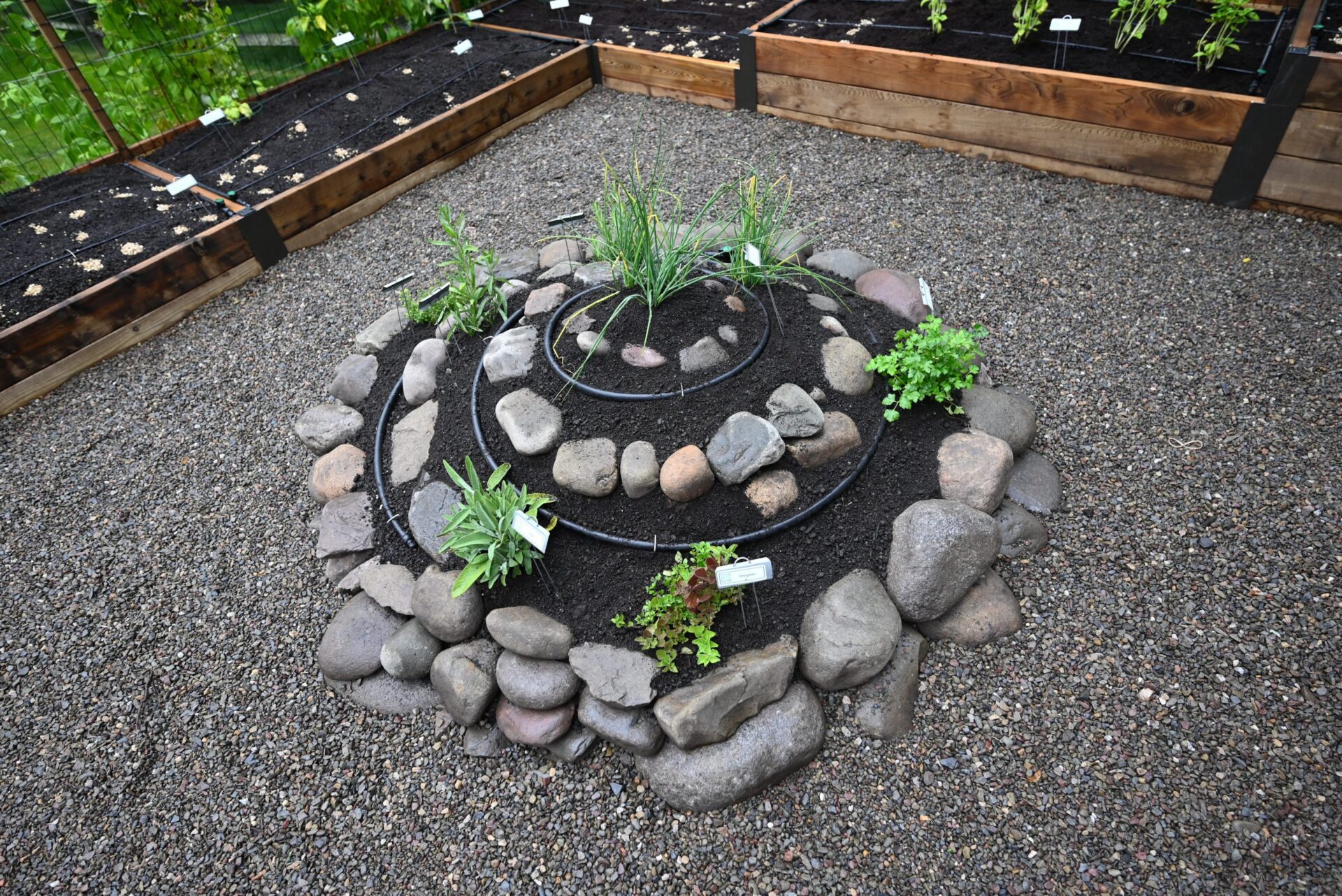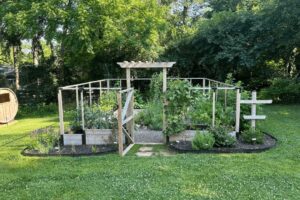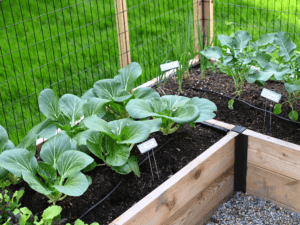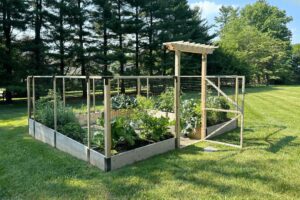
[et_pb_section fb_built=”1″ admin_label=”section” _builder_version=”4.16″ da_disable_devices=”off|off|off” global_colors_info=”{}” da_is_popup=”off” da_exit_intent=”off” da_has_close=”on” da_alt_close=”off” da_dark_close=”off” da_not_modal=”on” da_is_singular=”off” da_with_loader=”off” da_has_shadow=”on”][et_pb_row admin_label=”row” _builder_version=”4.16″ background_size=”initial” background_position=”top_left” background_repeat=”repeat” global_colors_info=”{}”][et_pb_column type=”4_4″ _builder_version=”4.16″ custom_padding=”|||” global_colors_info=”{}” custom_padding__hover=”|||”][et_pb_text _builder_version=”4.27.0″ _module_preset=”default” text_text_color=”#000000″ link_font=”|700|||on|||#000000|” link_text_color=”#000000″ global_colors_info=”{}”]
At Backyard Eats we’ve developed a proven system for designing, installing, and maintaining raised bed vegetable gardens to make growing food at home easy. However, did you know that we also offer edible perennials like blackberries, Mediterranean herbs, and other functional plants? Fall is the best time to plant perennials in your garden! Keep reading to learn why you should plant perennials in fall and the benefits they’ll provide for years to come.
[/et_pb_text][et_pb_text _builder_version=”4.27.0″ _module_preset=”default” text_text_color=”#000000″ link_font=”|700|||on|||#000000|” link_text_color=”#000000″ header_2_line_height=”1.5em” header_2_font_size_tablet=”” header_2_font_size_phone=”24px” header_2_font_size_last_edited=”on|phone” global_colors_info=”{}”]
Why Plant Perennials in Fall?
Fall creates an optimal planting environment for several reasons: including cooler temperatures and reduced pest pressure. Overall, fall presents less environmental stressors than summer which helps plants develop a strong root system before winter.
For example, fall’s cooler temperatures reduce heat stress on plants as they begin to establish roots; fall soil also retains some summer heat, which further reduces stress on plants compared to the still-cold ground one encounters during spring planting. Fall also typically offers more consistent rainfall than summer, which encourages growth and means less additional watering for you to worry about.
Additionally, perennials’ growth cycles are in sync with fall planting. Crops planted in fall will become dormant over winter, storing energy for growth in spring and giving them three seasons of head-start instead of trying to force them to begin growing in summer (for the reasons explained above). Lastly, fall presents reduced pest pressure compared to summer. This further increases perennials’ chance of a healthy start to prepare for growth next spring.
[/et_pb_text][et_pb_image src=”https://backyard-eats.com/wp-content/uploads/2024/06/13-2.jpg” title_text=”Project1L_BYE” show_bottom_space=”off” _builder_version=”4.27.0″ _module_preset=”default” custom_margin=”20px||20px||true|false” global_colors_info=”{}”][/et_pb_image][et_pb_text _builder_version=”4.27.0″ _module_preset=”default” text_text_color=”#000000″ link_font=”|700|||on|||#000000|” link_text_color=”#000000″ header_2_line_height=”1.5em” header_2_font_size_tablet=”” header_2_font_size_phone=”24px” header_2_font_size_last_edited=”on|phone” global_colors_info=”{}”]
Long-Term Benefits of Perennials
Once established, perennials require less overall maintenance than an annual raised bed vegetable garden. Notably, they don’t require re-planting every year or mid-season. Although some perennials, like raspberries or blackberries, do benefit from some pruning, they typically don’t require as vigorous training or pruning as annual crops like cucumbers or tomatoes which also grow on trellises. Perennials also require less frequent watering than annual crops, also they still benefit from deep watering at the roots. All of these lower maintenance needs mean that your initial investment in perennials will pay off quickly.
In general, perennials provide several environmental benefits to your soil and landscape. Their strong roots can help improve soil structure, reduce erosion, and retain water. You can even design a “rain garden” of different perennials designed to capture water at low or wet points in your yard! Edible perennials also provide habitats for beneficial insects and birds, and can enhance biodiversity in your neighborhood with pollinator-friendly plants like milkweed.
Finally, perennials provide unique aesthetic value to your landscape. They can soften the look of raised bed structures and add dynamic colors and textures to planting beds. Unlike raised beds, perennial planting beds and berry trellises can be placed more flexibly in your landscape according to sunlight, terrain, and other common garden planning factors. With a variety of plants, perennials can provide year-round interest as the seasons change.
[/et_pb_text][et_pb_image src=”https://backyard-eats.com/wp-content/uploads/2024/08/DSC_6544-1.jpg” title_text=”DSC_6544″ show_bottom_space=”off” _builder_version=”4.27.0″ _module_preset=”default” custom_margin=”20px||20px||true|false” global_colors_info=”{}”][/et_pb_image][et_pb_text _builder_version=”4.27.0″ _module_preset=”default” text_text_color=”#000000″ link_font=”|700|||on|||#000000|” link_text_color=”#000000″ header_2_line_height=”1.5em” header_2_font_size_tablet=”” header_2_font_size_phone=”24px” header_2_font_size_last_edited=”on|phone” global_colors_info=”{}”]
Best Perennials for Edible Landscapes
The most common berries we recommend for edible landscapes are strawberries, raspberries, and blackberries. These are not only popular choices to eat but also reliable to grow in our Pennsylvanian climate. As described above, these berries fare well with fall planting because they can take advantage of three cooler seasons before facing heat stress next summer.
In addition to more stereotypical edible plants like berries, flowers, pollinator-friendly plants, and plants with medicinal properties also make great additions to perennial planting beds and can also be planted in fall. Examples of these crops include echinacea, lemon balm, and yarrow. Did you know that echinacea not only has attractive flowers but can also be brewed in tea? If you’re interested in developing a pollinator garden, consider butterfly milkweed which is drought-resistant and favors full sun.
Figs, asparagus, rhubarb, and kitchen herbs like rosemary and sage are also great options! For food forests, choose a mix of perennials including trees, shrubs, and smaller herbaceous plants like sage. This not only creates visual interest but supports a diverse and healthy ecosystem.
[/et_pb_text][et_pb_image src=”https://backyard-eats.com/wp-content/uploads/2024/06/4-3.jpg” title_text=”4″ show_bottom_space=”off” _builder_version=”4.27.0″ _module_preset=”default” custom_margin=”20px||20px||true|false” global_colors_info=”{}”][/et_pb_image][et_pb_text _builder_version=”4.27.0″ _module_preset=”default” text_text_color=”#000000″ link_font=”|700|||on|||#000000|” link_text_color=”#000000″ header_2_line_height=”1.5em” header_2_font_size_tablet=”” header_2_font_size_phone=”24px” header_2_font_size_last_edited=”on|phone” global_colors_info=”{}”]
Practical Tips for Planting Perennials in Fall
Choosing the right location for your perennials is largely based on a combination of site factors and plant needs. Many perennials are drought-resistant, but some prefer full or partial sun while others thrive in shade.
As with raised bed gardens, it’s best to evaluate the sun score of your potential perennial beds and avoid low points where water pools until you’re specifically building a “rain garden.” Many of the same garden planning considerations, such as soil preparation and proper spacing, will also ensure your plants thrive and provide a rewarding gardening experience.
We recommend mulching perennial beds to reduce weed growth, retain moisture, and insulate against heat. With consistent moisture levels and less heat stress, edible perennials planted in fall will develop roots better than if they were planted in summer and watered less frequently. Conversely, mulch will also help retain some heat in winter which is also beneficial for tender young plants. We also recommend covering fig trees with layers of burlap and straw to help them survive the winter.
[/et_pb_text][et_pb_image src=”https://backyard-eats.com/wp-content/uploads/2024/06/12-4.jpg” title_text=”12″ show_bottom_space=”off” _builder_version=”4.27.0″ _module_preset=”default” custom_margin=”20px||20px||true|false” global_colors_info=”{}”][/et_pb_image][et_pb_text _builder_version=”4.27.0″ _module_preset=”default” text_text_color=”#000000″ link_font=”|700|||on|||#000000|” link_text_color=”#000000″ header_2_line_height=”1.5em” header_2_font_size_tablet=”” header_2_font_size_phone=”24px” header_2_font_size_last_edited=”on|phone” global_colors_info=”{}”]
Conclusion
Investing in fall-planted perennials offers numerous benefits for your landscape, from reduced maintenance and long-term cost savings to enhanced environmental health and aesthetic appeal. By planting perennials like berries, Mediterranean herbs, and drought-resistant crops, you not only create a sustainable and functional garden but also support local wildlife and biodiversity.
At Backyard Eats, we are passionate about helping you design and implement an edible landscape that will thrive for years to come. If you’re ready to transform your garden this fall, book a consultation and let us help you reap the rewards of a well-planned perennial planting.
[/et_pb_text][et_pb_button button_url=”@ET-DC@eyJkeW5hbWljIjp0cnVlLCJjb250ZW50IjoicG9zdF9saW5rX3VybF9wYWdlIiwic2V0dGluZ3MiOnsicG9zdF9pZCI6IjU4MjY0In19@” url_new_window=”on” button_text=”BOOK A CONSULTATION” button_alignment=”left” button_alignment_tablet=”left” button_alignment_phone=”left” button_alignment_last_edited=”on|tablet” disabled_on=”off|off|off” _builder_version=”4.27.0″ _dynamic_attributes=”button_url” _module_preset=”737bea5a-e063-4b24-af3f-21ce28f0bf38″ button_bg_color=”gcid-3b5ac83a-684c-4379-a559-60b2aa9e8157″ button_border_color=”gcid-3b5ac83a-684c-4379-a559-60b2aa9e8157″ button_letter_spacing=”1px” button_font=”Roboto|700||on|||||” z_index=”90″ custom_margin=”0px|0px|30px|0px|false|false” custom_margin_tablet=”0px|0px|0px|0px|false|false” custom_margin_phone=”0px|0px|0px|0px|false|false” custom_margin_last_edited=”on|desktop” locked=”off” global_colors_info=”{%22gcid-3b5ac83a-684c-4379-a559-60b2aa9e8157%22:%91%22button_border_color__hover%22,%22button_bg_color%22,%22button_border_color%22%93}” button_text_color__hover_enabled=”on|hover” button_text_color__hover=”#844B67″ button_bg_enable_color__hover=”on” button_border_color__hover=”#88667b” button_border_color__hover_enabled=”on|desktop”][/et_pb_button][/et_pb_column][/et_pb_row][/et_pb_section]






